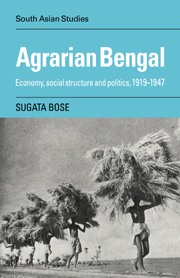Book contents
- Frontmatter
- Contents
- List of maps
- Preface
- List of abbreviations
- PART I AGRARIAN ECONOMY AND SOCIETY: STRUCTURE AND TRENDS
- 1 Introduction: A typology of agrarian social structure in early twentieth-century Bengal
- 2 Subsistence and the market I
- 3 Subsistence and the market II: The peasants' produce
- 4 The peasantry in debt: The working and rupture of systems of rural credit relations
- 5 Peasants into proletarians? The market in land and the question of change in the social organisation of production
- PART II PEASANTS AND POLITICS
- Conclusion
- Glossary
- Select bibliography
- Index
4 - The peasantry in debt: The working and rupture of systems of rural credit relations
from PART I - AGRARIAN ECONOMY AND SOCIETY: STRUCTURE AND TRENDS
Published online by Cambridge University Press: 24 October 2009
- Frontmatter
- Contents
- List of maps
- Preface
- List of abbreviations
- PART I AGRARIAN ECONOMY AND SOCIETY: STRUCTURE AND TRENDS
- 1 Introduction: A typology of agrarian social structure in early twentieth-century Bengal
- 2 Subsistence and the market I
- 3 Subsistence and the market II: The peasants' produce
- 4 The peasantry in debt: The working and rupture of systems of rural credit relations
- 5 Peasants into proletarians? The market in land and the question of change in the social organisation of production
- PART II PEASANTS AND POLITICS
- Conclusion
- Glossary
- Select bibliography
- Index
Summary
In early twentieth-century Bengal, the debt relation worked simultaneously as a mode of surplus-appropriation and as a vital factor in the reproduction of existing agrarian structures. Rent itself had by now become less important as a means of surplus-appropriation than the credit mechanism. At the same time, borrowing in cash and in grain for both cultivation and consumption purposes had come to play an integral role in sustaining production in the peasant economy and in its reproduction over time.
The reproductive function of the credit relation through the annual replenishment of working capital and a consumption fund of peasant families can be observed in relation to each of the types of agrarian social structure that predominated in the different regions. The social composition and character of the creditor groups and consequently the nature of the creditor–debtor relationship varied, of course. As for the surplus-appropriating function, the relative importance of the rental and credit markets and the links between the two need further clarification. In the strongly market-oriented economy of east Bengal where raiyati rent was low and difficult to collect, the interlinked product and credit markets had developed into far more important channels of the drain on the peasantry. Some of the rentiers of old had learnt, however, to play the credit market. In west Bengal, rates of raiyati rent continued to be relatively high.
- Type
- Chapter
- Information
- Agrarian BengalEconomy, Social Structure and Politics, 1919-1947, pp. 98 - 145Publisher: Cambridge University PressPrint publication year: 1987



